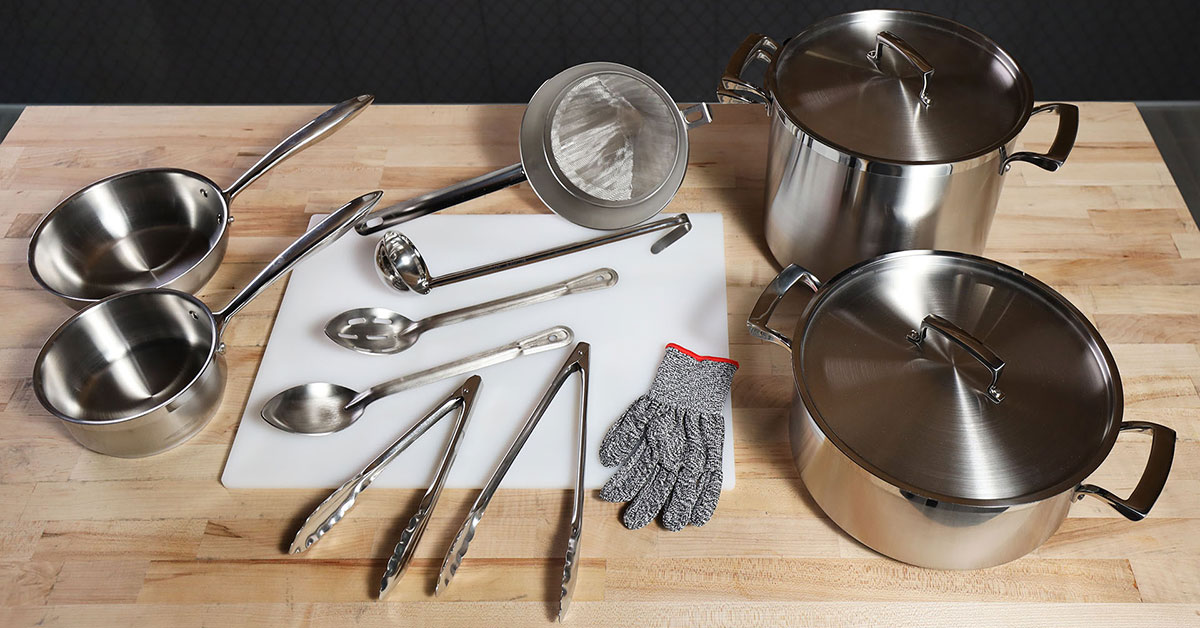With Scott Smith, Director of Online Culinary Programs &
Thomas DeRosa, Associate Professor, College of Food Innovation
& Technology
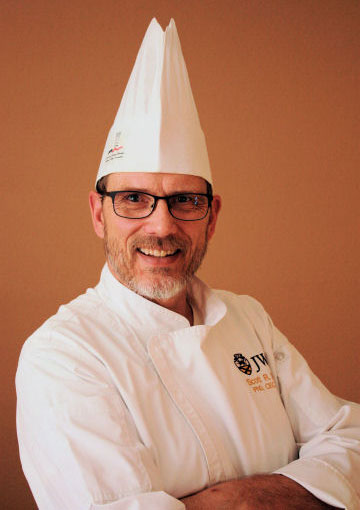
Students in the online Professional Culinary Skills (PCSK) Certificate program typically cook and prepare food in their own home for the food production assignments, which range from traditional techniques of stewing, braising and roasting to poaching, steaming, blanching, shocking, boiling and simmering. The final capstone course challenges students to apply high-level contemporary culinary skills toward the exploration of global cuisines and cultures.
What’s provided for students?
To execute these assignments, Scott Smith, Director of Online Culinary Programs for JWU Online emphasizes, “JWU wants to provide students with the opportunity to use professional grade tools and cookware while preparing their food production assignments.” Students are provided with the following:
- JWU uniform
- 16-piece cookware kit, including:
- basic utensils
- a stock pot
- a brazier, sauté pan and more
- 14-piece knife kit, including:
- chef’s knife
- paring knife
- slicer
- knife cuts model and more
- Spice rack
- Camera & small tripod
- attaches to your laptop for recording cooking assignments
When you contact admissions, be sure to request the full, illustrated Online Culinary Chef’s Tool Kit List.
Smith notes that, “Students will need to have access to cooking equipment such as an oven, stove, and refrigeration.” He adds, “Additional small wares beyond what is shipped will be needed to produce certain assignments. Typically, in each course, students will receive a list of items they will need.”
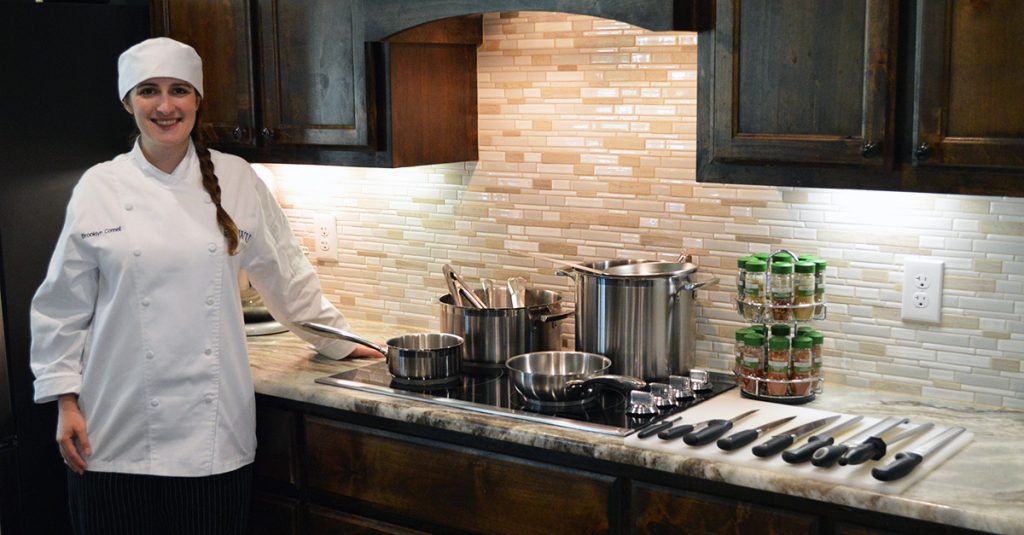
Describing her excitement about the tool kit, Brooklyn Connell, ’23 exclaimed: “It felt like Christmas when multiple packages of equipment arrived at my home! Inside the boxes were a bunch of knives, a giant cutting board, and pots and pans. Even after the program has ended, I continue to love using all my knives and my giant cutting board.”
General advice for the kitchen
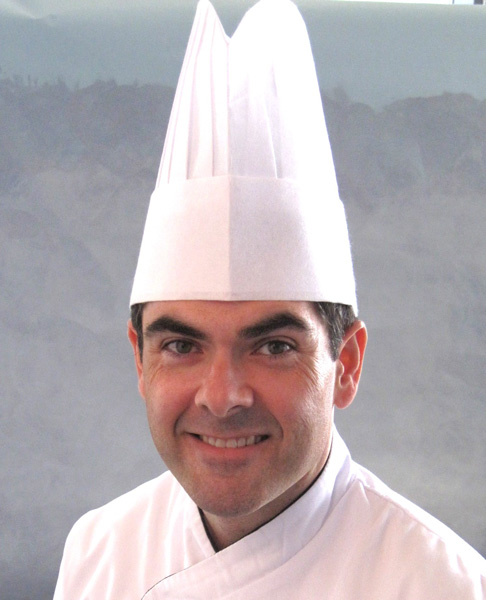
Thomas DeRosa, Associate Professor in the College of Food Innovation & Technology, tells us, “The one tool I cannot live without is my sharp chef’s knife. I have several in my toolkit, each varying in length, profile, and blade thickness, with a specific purpose for each task. Whether I’m fabricating chicken or beef, or delicately mincing shallots or fresh herbs, I always choose the appropriate tool for the job, and my chef’s knife fits the bill perfectly.
“Another important tip is to invest in several cutting boards. Stopping to wash and sanitize a cutting board takes up valuable time during prep and cooking. Instead, simply place the dirty cutting board in the sink, quickly wipe and sanitize your work surface or countertop, and replace it with another clean one. Always secure your cutting board by placing a damp paper towel underneath it to prevent movement. Remember, physical safety is just as important as food safety.”
Choosing the right culinary tool
Smith explains, “When cooking food, it is important to choose the correct tool and cookware to use based on what one will be cooking. Although there may be versatility in many tools and cookware, often one-size does not necessarily fit all – which is why a variety of pots and pans are provided to students in the tool kit.”
DeRosa explains the principle that governs his choice of culinary tools when executing a new recipe or when he encounters a cooking challenge.
“Mise en Place (‘meez-on-plahs’) is a French culinary term meaning ‘everything in its place.’ In the kitchen, this involves having all your ingredients and equipment prepped, organized and accessible before you begin cooking.
“Philosophically, Mise en Place serves as a guiding principle for all chefs. Before diving into the actual cooking, it’s essential to understand each recipe, ingredient, technique, term and piece of equipment, as well as how they function.
“This approach of Mise en Place streamlines the cooking process. By ensuring that everything is in its place, I can focus on executing the recipe efficiently and effectively, resulting in a more successful and enjoyable cooking experience and a well-prepared finished dish.”
Tips for success online culinary program
“While learning about the right tools and equipment is essential, one important factor that contributes to success for aspiring culinary professionals is communication,” advises DeRosa. “Maintaining communication with your instructor is paramount. We are here to help and guide you during your culinary journey.”
Rich Clay, ‘23 commented, “Whenever I submitted my class assignments or emailed with questions, I received a response within a day. The support from the culinary faculty helped me meet the challenge of earning the degree online.”
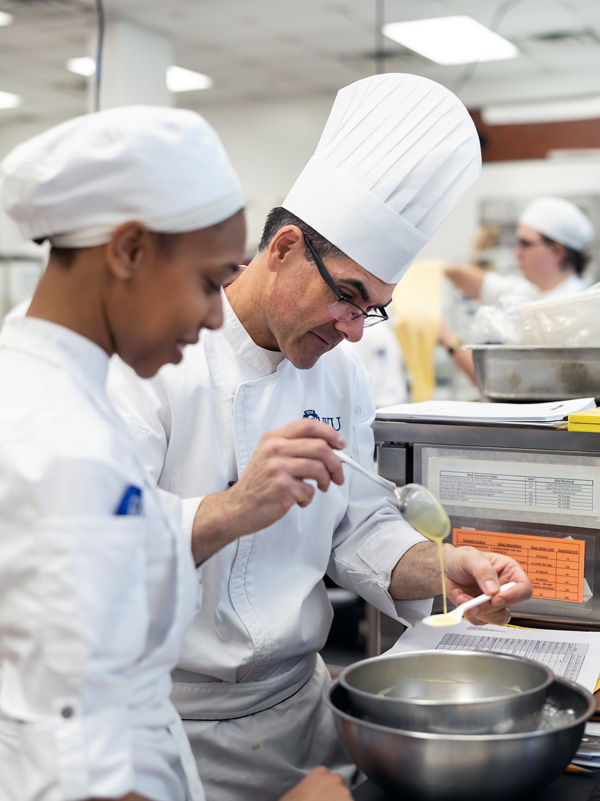
“Tell your friends, family, and employer that you are enrolled in school. Invite them to watch you perform your cooking assignments and feed them your cooking creations,” suggests DeRosa.
Sara Osorio, ’23 shared, “While in the program, some friends liked my cooking so much, that when I let them know that I had leftovers, they would drive to my house to pick up the food!”
DeRosa adds, “Keeping your employer informed about your coursework and progress can also be beneficial, as they might provide support or even opportunities for you to apply your skills in a professional setting.”
Practice, practice, practice
DeRosa continues, “Lastly, cultivate self-discipline and time management. Online learning requires you to take initiative and stay organized. Set a consistent schedule for your studies and practice. Dedicate time each week to refine your techniques and reflect on your progress. This commitment to your craft will enhance your skills and inspire confidence as you advance in your culinary career.”
Clay acknowledged, “The program gives a very thorough professional training, which demanded a good deal of time. Managing work and school, I learned to be more self-disciplined and understood how to better budget my time – a skill I use now at work.”
Ensuring quality and accessibility
DeRosa, who teaches full-time at JWU’s Charlotte campus shares that, “Teaching in the online culinary program excites me because it enables me to connect with passionate students from diverse backgrounds from across the country. I love sharing my knowledge and enthusiasm for culinary arts in a flexible environment that accommodates their unique schedules.
“The JWU PCSK program’s asynchronous structure enables students to learn at their own pace while receiving top-notch instruction from seasoned culinary art instructors. This blend of quality and accessibility ensures that our online courses maintain the rigorous standards that Johnson & Wales University is known for, fostering a rich learning experience for all.”
Interested in Advancing Your Culinary Career?
Johnson & Wales Online, in collaboration with JWU’s College of Food Innovation & Technology, is now enrolling for the Spring 2025 online Professional Culinary Skills Certificate program.
A worldwide leader in culinary education, JWU Online prepares graduates to advance their culinary career paths with skills and knowledge of food preparation through this 100% online certificate program. For more information about the PCSK program at Johnson & Wales Online, complete the Request Info form, call 855-JWU-1881, or email [email protected].
